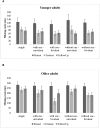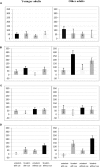Age Differences in the Transfer and Maintenance of Practice-Induced Improvements in Task Switching: The Impact of Working-Memory and Inhibition Demands
- PMID: 28367135
- PMCID: PMC5355431
- DOI: 10.3389/fpsyg.2017.00410
Age Differences in the Transfer and Maintenance of Practice-Induced Improvements in Task Switching: The Impact of Working-Memory and Inhibition Demands
Abstract
Recent aging studies on training in task switching found that older adults showed larger improvements to an untrained switching task as younger adults do. However, less clear is what type of cognitive control processes can explain these training gains as participants were trained with a particular type of switching task including bivalent stimuli, requiring high inhibition demands, and no task cues helping them keeping track of the task sequence, and by this, requiring high working-memory (WM) demands. The aims of this study were first to specify whether inhibition, WM, or switching demands are critical for the occurrence of transfer and whether this transfer depends on the degree of overlap between training and transfer situation; and second to assess whether practiced-induced gains in task switching can be maintained over a longer period of time. To this end, we created five training conditions that varied in switching (switching vs. single task training), inhibition (switching training with bivalent or univalent stimuli), and WM demands (switching training with or without task cues). We investigated 81 younger adults and 82 older adults with a pretest-training-posttest design and a follow-up measurement after 6 months. Results indicated that all training and age groups showed improvements in task switching and a differential effect of training condition on improvements to an untrained switching task in younger and older adults. For younger adults, we found larger improvements in task switching for the switching groups than the single-task training group independently of inhibition and WM demands, suggesting that practice in switching is most critical. However, these benefits disappeared after 6 months. In contrast, for older adults training groups practicing task switching under high inhibition demands showed larger improvements to untrained switching tasks than the other groups. Moreover, these benefits were maintained over time. We also found that the transfer of benefits in task switching was larger with greater overlap between training and transfer situation. However, results revealed no evidence for transfer to other untrained cognitive task. Overall, the findings suggest that training in resolving interference while switching between two tasks is most critical for the occurrence of transfer in the elderly.
Keywords: aging; inhibition; task-switching training; transfer; working memory.
Figures




Similar articles
-
Training and Transfer of Cue Updating in Older Adults Is Limited: Evidence From Behavioral and Neuronal Data.Front Hum Neurosci. 2020 Dec 4;14:565927. doi: 10.3389/fnhum.2020.565927. eCollection 2020. Front Hum Neurosci. 2020. PMID: 33343316 Free PMC article.
-
Adaptive working-memory training benefits reading, but not mathematics in middle childhood.Child Neuropsychol. 2015;21(3):285-301. doi: 10.1080/09297049.2014.899336. Epub 2014 Apr 3. Child Neuropsychol. 2015. PMID: 24697256 Clinical Trial.
-
Neural correlates of training and transfer effects in working memory in older adults.Neuroimage. 2016 Jul 1;134:236-249. doi: 10.1016/j.neuroimage.2016.03.068. Epub 2016 Apr 1. Neuroimage. 2016. PMID: 27046110
-
Immediate and long-term efficacy of executive functions cognitive training in older adults: A systematic review and meta-analysis.Psychol Bull. 2019 Jul;145(7):698-733. doi: 10.1037/bul0000196. Epub 2019 Apr 18. Psychol Bull. 2019. PMID: 30998045
-
Interventions targeting working memory in 4-11 year olds within their everyday contexts: A systematic review.Dev Rev. 2019 Jun;52:1-23. doi: 10.1016/j.dr.2019.02.001. Dev Rev. 2019. PMID: 31417204 Free PMC article. Review.
Cited by
-
Feasibility of a Home-Based Task-Switching Training in Middle-Aged Caregivers.J Cogn Enhanc. 2022;6(3):295-315. doi: 10.1007/s41465-021-00237-0. Epub 2022 Jan 7. J Cogn Enhanc. 2022. PMID: 35966367 Free PMC article.
-
The Effect of Baseline Performance and Age on Cognitive Training Improvements in Older Adults: A Qualitative Review.J Prev Alzheimers Dis. 2021;8(1):100-109. doi: 10.14283/jpad.2020.55. J Prev Alzheimers Dis. 2021. PMID: 33336231 Free PMC article. Review.
-
Training and Transfer of Cue Updating in Older Adults Is Limited: Evidence From Behavioral and Neuronal Data.Front Hum Neurosci. 2020 Dec 4;14:565927. doi: 10.3389/fnhum.2020.565927. eCollection 2020. Front Hum Neurosci. 2020. PMID: 33343316 Free PMC article.
-
Training and transfer effects of extensive task-switching training in students.Psychol Res. 2020 Mar;84(2):389-403. doi: 10.1007/s00426-018-1059-7. Epub 2018 Jul 17. Psychol Res. 2020. PMID: 30019270 Free PMC article.
-
Spatio-Temporal Neural Changes After Task-Switching Training in Old Age.Front Aging Neurosci. 2019 Oct 15;11:267. doi: 10.3389/fnagi.2019.00267. eCollection 2019. Front Aging Neurosci. 2019. PMID: 31680929 Free PMC article.
References
-
- Grange J. A., Houghton G. (2014). Task Switching and Cognitive Control. New York, NY: Oxford University Press; 10.1093/acprof:osobl/9780199921959.001.0001 - DOI
LinkOut - more resources
Full Text Sources
Other Literature Sources

